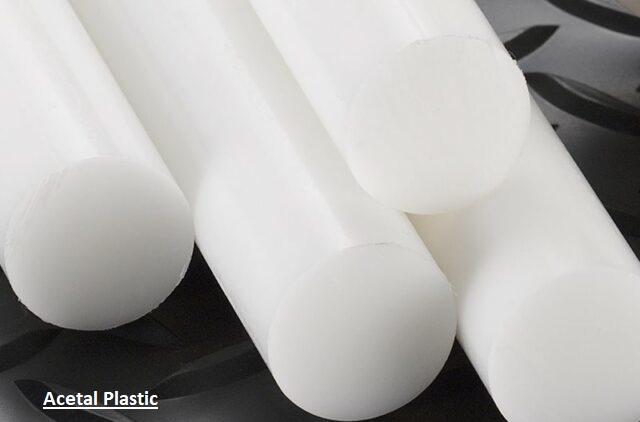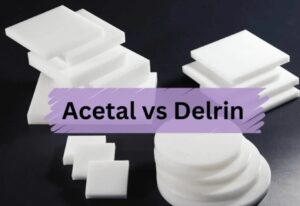Acetal plastic is also known as polyoxymethylene, which is a strong and high-quality thermoplastic material. It provides a high strength-to-weight ratio and good stability. This material is used to provide accurate and low-friction features and parts of gears, bearings, and electrical components.
These materials also have good chemical resistance and are best used for harsh conditions. It also has resistance to moisture and a low coefficient of thermal expansion. Here we will cover its details and related parameters.
What is Acetal Plastic?
- POM plastic is a semi-crystalline thermoplastic that comes with formaldehyde molecules. So it is used as polyformaldehyde and polyoxyethylene glycol.
- Its polymer provides a carbon operating group configured with 2 or more groups that provide good mechanical and chemical features.
- Acetal plastic is a replacement for metals, so it is used in mechanical gears, electrical components, vehicle components, medical device hardware, etc.
- Acetal comes with low friction and is good to use for smooth motion and high-resistance parts.
- It also provides resistance to different chemicals, like hydrocarbons, solvents, and neutral chemicals.
- It has features to handle wet and dry conditions and helps to make acetal products with a longer working life.
Features of Acetal Plastic
The main features of acetal plastic are as follows.
High mechanical strength
- Acetal plastic comes with a rigid structure and is good to use for providing high mechanical strength. It has strong chemical bonds between different polymer chains that make materials. It also has high load-bearing features and parts of gears, bearings, and components that face loads and stress.
Low moisture absorption
- Acetal plastic also has a low water absorption rate, so it absorbs low moisture. So it is resistant to changes in dimensions due to changes in humidity. It is good to use for applications where dimension is the main factor.
chemical resistance
- This plastic has tightly packed polymer chains that help to handle different chemicals like acids, bases, and solvents. so it is good to use for providing chemical resistance in chemical processing, beverage, and medical applications.
Low coefficient of friction
- Acetal plastic has a low coefficient of friction, so it reduces resistance between two surfaces. It is good to use for bearings, gears, and for applications where low friction is needed.
| Property | ASTM Test | Value |
| Density | – | 1.39 to 1.43 g/cm3 |
| Tensile Strength | D638 | 10,000 psi |
| Flexural Modulus of Elasticity | D790 | 420 ksi |
| Tensile Modulus of Elasticity | D638 | 450 ksi |
| Water absorption | D570 | 0.25% |
| Heat Deflection Temperature | D648 | 336 °F |
| Coefficient of Friction | Dynamic | 0.2 |
Copolymer vs Homopolymer Acetal Plastics
|
Acetal homopolymers
|
Acetal copolymers |
| It has a regular structure | It provide good working for longer duration applications. |
| It has short molding cycles | it has a stable alkaline nature and resistance to chemicals |
| It has good mechanical features like tensile strength and impact strength | gas release |
| stronger | Higher processing times |
| It is used for thin wall designs and lightweight components | It has protection from UV |
| It has different values of viscosities | Dimensionally stable |
| low cost | Good color retention |
Advantages of Acetal Plastic
- It is dimensionally stable and provides resistance for machined operation.
- It has a low friction coefficient and provides resistance to wear.
- It has high tensile strength and a design with a low absorption of moisture in different conditions.
- It provides resistance to fuels and organic solvents.
- It releases smoke emission and has high aesthetic surface finishes.
- It has a recyclable nature and FDA-approved features.
- It is used with a mixture of graphite, rubber, glass-filled materials, and metals to increase its features.
Disadvantages of Acetal Plastic
- It has a weak structure for strong bases, acids, and oxidizers.
- It can burn due to high oxygen concentration and shrink in mold.
- It has low resistance to UV radiation without protection and is affected by color and strength if it stays longer in the sun.
- It needed some surface treatment before bonding with glue.
- It’s a machine process more difficult than other metals and also hazardous if inhaled.
Difference Between Acetal Plastic and Delrin
Delrin is an acetal homopolymer and can be used as a replacement for the same type. Delrin has the same features as acetal plastics.
- It provides good friction and abrasion resistance with a strong dimensional structure.
- It has low moisture absorption and works well in moist conditions.
- It has good electrical features and is compatible with FDA and USDA compliance.
- The basic difference between Delrin and acetal plastics stems from the composition of homopolymers that have a crystalline structure rather than having different subunits.
- It is made to be used for certain applications where high stiffness is needed, also for flex fatigue resistance and creep resistance, more than copolymers.
- Derlin provides good mechanical strength.
- The disadvantage is that it has high centerline porosity, which has in inconsistency for the plastic middle, which results in gas being released in the cooling process.
Acetal Plastic Alternatives
The common replacement used for acetal plastic is as.
Delrin:
- Delrin is a brand-defined homopolymer made by DuPont and used in different industries. It has different features from acetal plastic, since acetal plastic comes in copolymer form and Delrin is a special homopolymer blend.
- Delrin is used in industrial applications like valve components, pump insulators, and rollers.
Nylon:
- Nylon is a thermoplastic that has high temperature resistance, good tensile strength, stiffness, and low cost as compared to acetal plastic and is normally used as a replacement. Nylon is also used as a replacement for acetal plastics, but it has a low stable design, low resistance to chemicals, and is affected by moisture.
- nylon used in electronics, clothing, and consumer goods
Uses of Acetal Plastic
- Acetal plastic is used in different industries. The main use is to produce gears, bearings, and mechanical parts.
- It has low friction and high strength, so it is used for heavy-load applications and has a stable nature.
- Acetal plastic is also part of vehicles and also used in fuel systems and transmission parts.
- It has chemical resistance that makes it useful in chemical component handling.
- It is used for making consumer goods like toys and appliances.
- Its low-friction features make it useful for electronic devices like connectors and switches.
Acetal Plastic vs. Nylon Plastic
Properties of Acetal Plastic
- It has high chemical resistance and a low coefficient of friction.
- It has high dimensional stability and good electrical features.
- It has good machinability features and low moisture absorption and porosity.
- It has good wear resistance.
Properties of Nylon Plastics
- It has good chemical resistance and a low coefficient of friction.
- It has high wear resistance and compatibility with FDA- and USDA-compliant
FAQs
What are the uses of Acetal plastic?
- Acetal plastic is used as a replacement for metals, so it is used for mechanical gears, vehicle parts, electrical components, medical devices, hardware, and construction tools.
What are the properties of Acetal material?
- Acetal is a high-strength, low-friction engineering plastic that has good wear features for dry and wet conditions. Acetal has resistance to hydrocarbons, solvents, and neutral chemicals.
What are the useful properties of plastic?
- It has low weight and a stable nature.
- Its shape can be changed into different sizes and dimensions.
- It provides insulation and low thermal conductivity.
- It has high impact resistance and does not get rust.
- It provides wear resistance and transparency.
What is the maximum temperature for acetal plastic?
- Acetal, also called POM, is a semi-crystalline engineering thermoplastic material, and the temperature range is 180°F. Acetal has good strength and stiffness and is configured with high dimensional strength.

